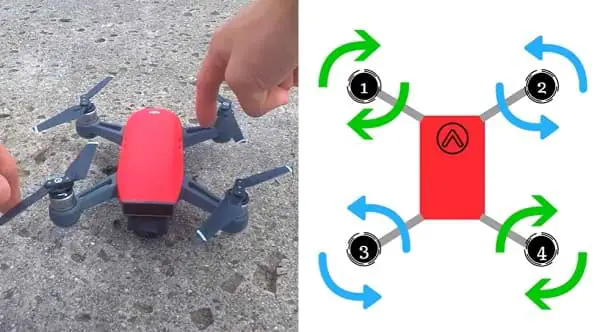
All drones require propellers in order to take flight. Most drones these days are classified as quadcopters, which means they have 4 propellers, but I’ve always wondered why this number in particular? I’ve done my research and here’s what I found.
Just like the best way to design a car is with four tires, the best way to make a drone fly is for it to have 4 points of thrust to stabilize and lift the drone. Quadcopters also lack the aerodynamic efficiency to use a single rotor. Through trial and error over the decades, this is the most economical way of producing a drone. Quadcopters also lack the aerodynamic efficiency to use a single rotor.
If you want to find out more about how drones work and the mechanics behind its movement, then keep reading!
How Do Drones Work?
Drones fly due to the propeller’s direction along with the drone’s motor rotation and speed. These combined factors are what makes a drone flight and maneuverability possible.
A Quadcopter’s flight controller sends info to the motors on thrust, Revolutions Per Minute(RPM), and the direction it should be flying.
Drones are modern machinery, and most of the technology in them is very advanced; however, they still use the old principles of aircraft flight, gravity, action, and reaction pairs.
How They Fly
When you move the joystick on the remote control, this sends a signal to the central flight controller.
The central flight controller then sends that info to the ESCs (Electronic Speed Controllers) located in each motor. When this signal is sent, then, this signal directs the motors to reduce or increase the speed of the propellers.
Why Does This Design Work?
The main reason why drones are so popular and easy to make is because of their mechanical simplicity. A quadcopter uses four motors that are connected to four fixed-pitch propellers. This means that the propellers are literally connected directly to the motors
There is one single moving point or part for each of the four propellers. This is why the quadcopter design is extremely simple. Drones are mechanically simpler, which makes them potentially cheap to make because of the design they have.
Propeller Design
Propellers come in all shapes, sizes, prices, and materials. The material and design of the propeller will ultimately determine how much the propellers will cost.
When it comes to propellers and your drone, you do not want propellers that produce a lot of vibration when spinning. You also don’t want propellers that are heavy in weight.
These things will affect the way your drone flies. This may not mean much to a lot of people, but to someone who really wants to capture some fantastic drone footage, they might want to spend a little bit extra on their propellers.
If you are looking to improve your quadcopter, then you should consider these factors when choosing new props:
Length: The length of your chosen propellers is very important when selecting props for a drone. The length of the props is usually measured as the diameter of a disc the propellers make when they are spinning.
The higher the Kv(constant velocity) rating of your drone’s motors, the smaller your propellers should be. When the propellers on a drone are smaller, this allows for higher speeds to be achieved, but the efficiency is then reduced.
If you are trying to build your own quadcopter, then you should look at the manufacturers’ recommendations to try and gauge what kind of motors and propellers your drone should have.
Material: Most drone propellers are made from a different material, but this material is generally plastic. The higher-end propellers, however, are usually made from carbon fiber, but you can also find wooden propellers used for model aircraft.
Rotation: The rotation in which the props spin is essential. There are two types of rotation, Clockwise(CW) and Counter-clockwise(CCW). Drones have four propellers, clockwise and counter-clockwise props have different designs.
You need to match CW and CCW propellers if you want your drone to generate thrust, this will also produce opposing yaw motion that will cancel each other when the drone is flying.
Can a Drone Fly With 3 Propellers?
Drones come in many different shapes and sizes, from quadcopters to drones with a multirotor system and tons of propellers.
Depending on the type of drone you have, Trying to fly when losing a propeller could either mean you have a costly crash landing into the ground from hundreds of feet in the air, or your drone could have a very shaky flight back to you!
Usually, the drones that continue to fly when losing a propeller are the drones with a multirotor system, making them a lot more well-balanced when losing a propeller.
On the other hand, crashing or landing a quadcopter all depends on where the center of gravity is located, and where the thrust is created. Quadcopters are not meant to fly with just three propellers, so when they lose one as they will immediately lose their balance.
When a drone has four propellers, the center of gravity is sat within a box that is created between the four props. This is usually where the load is located.
When a propeller fails or brakes during flight, that box created by the four points of the propellers and motors then turns into a triangle. If the load is still sitting within that triangle, then the drone may continue to fly or at least land safely.
The drone will obviously be off-balance because there will be two propellers that are fully operational providing most of the lift, and one non-paired operational propeller trying to maintain the balance of the drone.
If there is some wind, then you can just forget about that drone staying in the air! It will probably spin out because of the lack of a fourth propeller to maintain balance.
To be completely honest, if you happen to lose a propeller somehow while flying, your best hope is a controlled crash landing. The drone might not just drop out of the sky when losing a propeller, but it is definitely not staying in the air!
However, hexacopters and octocopters are a different story because these drones have more propellers. This means that if they lose a propeller while still in flight, it won’t affect their ability to stay in the air.
There are more propellers to keep it airborne. To be fair, the flight won’t be the smoothest, and the footage will not be the greatest, but at least the drone will make it back to you.
Do Drones Need Propellers?
Drones are constantly improving every single day and as technology is developed, manufacturers continue to add this new and improved tech to drones.
Drones have plenty of room to be improved, and there are people out there trying to improve the way drones are designed right now.
Marcus King, a student from the Royal College of Art, has designed a drone that uses another way to get the drone off the ground instead of the conventional propeller approach.
King’s drone uses centrifugal fans, otherwise known as impellers, rather than using propellers to create thrust. But how does this drone work?
The drone works similar to a leaf blower, but instead of air being pulled from the back and out the front, the air is pulled in from the side and pushed downwards.
Regular drones use propellers to create thrust that pushes them off the ground. The impeller drone, designed by Marcus, also does the same but with this leaf blower-like design. This is made possible thanks to a design that redirects the air towards the ground in order for the drone to take off.
If you want to read more about Marcus’ drone, read more about it in my article “Drones Without Propellers: Do They Exist?“
